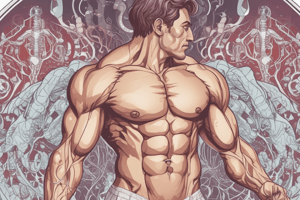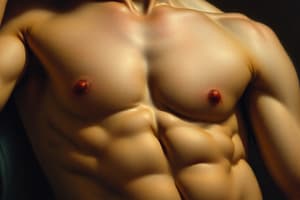Podcast
Questions and Answers
What is the primary function of testosterone?
What is the primary function of testosterone?
- Prepares the uterus for implantation
- Promotes follicular growth
- Inhibits ovulation
- Stimulates sperm production and promotes sex drive (correct)
Which steroid is identified as the model molecule for estrogens?
Which steroid is identified as the model molecule for estrogens?
- Androstenedione
- Testosterone
- Progesterone
- 17β-estradiol (correct)
What type of steroid hormone is progesterone classified as?
What type of steroid hormone is progesterone classified as?
- C17 steroid
- C21 steroid (correct)
- C18 steroid
- C19 steroid
What triggers menstruation if fertilization does not occur?
What triggers menstruation if fertilization does not occur?
Which hormone signals the ovaries to produce more estrogen as the dominant follicle grows?
Which hormone signals the ovaries to produce more estrogen as the dominant follicle grows?
What is the main physiological role of estrogens?
What is the main physiological role of estrogens?
What type of enzymes do testes and ovaries contain that is crucial for the conversion of androgens to testosterone?
What type of enzymes do testes and ovaries contain that is crucial for the conversion of androgens to testosterone?
During the second half of the menstrual cycle, which hormone is primarily produced by the corpus luteum?
During the second half of the menstrual cycle, which hormone is primarily produced by the corpus luteum?
What is the main symptom of vitamin D deficiency in adults?
What is the main symptom of vitamin D deficiency in adults?
Which of the following is a prominent characteristic of rickets?
Which of the following is a prominent characteristic of rickets?
How do carotenoids contribute to human health?
How do carotenoids contribute to human health?
Which pigment is responsible for the coloration of carrots and tomatoes?
Which pigment is responsible for the coloration of carrots and tomatoes?
What role do carotenoids play in photosynthetic organisms?
What role do carotenoids play in photosynthetic organisms?
What is a vitamin A function associated with provitamin A carotenoids?
What is a vitamin A function associated with provitamin A carotenoids?
How do carotenoids affect cardiovascular health?
How do carotenoids affect cardiovascular health?
What is the primary source of vitamin D2 in the human diet?
What is the primary source of vitamin D2 in the human diet?
What percentage of total free cholesterol in the body is contained in the vertebrate brain?
What percentage of total free cholesterol in the body is contained in the vertebrate brain?
What distinguishes carotenoids from other pigments?
What distinguishes carotenoids from other pigments?
What is the common precursor for the synthesis of cholesterol that is mentioned?
What is the common precursor for the synthesis of cholesterol that is mentioned?
What is the effect of phytosterols on cholesterol levels in the body?
What is the effect of phytosterols on cholesterol levels in the body?
Which of the following statements about phytosterols is true?
Which of the following statements about phytosterols is true?
What is the main structural difference between vitamins D2 and D3?
What is the main structural difference between vitamins D2 and D3?
Which phytosterol is commonly present in all plant lipids?
Which phytosterol is commonly present in all plant lipids?
What biological activities do phytosterols exhibit in animals and humans?
What biological activities do phytosterols exhibit in animals and humans?
What is the primary role of cortisol in the human body?
What is the primary role of cortisol in the human body?
Which hormone is produced directly from pregnenolone?
Which hormone is produced directly from pregnenolone?
Where is aldosterone primarily produced in the body?
Where is aldosterone primarily produced in the body?
What type of steroid is testosterone classified as?
What type of steroid is testosterone classified as?
Cholesterol is primarily found in significant quantities in which of the following tissues?
Cholesterol is primarily found in significant quantities in which of the following tissues?
What is the classification of sterols in relation to their structure?
What is the classification of sterols in relation to their structure?
What role does progesterone play in the menstrual cycle?
What role does progesterone play in the menstrual cycle?
Which of the following sterols is primarily produced in the ovary?
Which of the following sterols is primarily produced in the ovary?
What is the biologically active form of vitamin D?
What is the biologically active form of vitamin D?
Which vitamin D form is synthesized in the skin upon UVB exposure?
Which vitamin D form is synthesized in the skin upon UVB exposure?
What is the primary function of calcitriol in the body?
What is the primary function of calcitriol in the body?
Which enzyme is responsible for hydroxylating cholecalciferol at the C-25 position in the liver?
Which enzyme is responsible for hydroxylating cholecalciferol at the C-25 position in the liver?
What role does ergosterol have in vitamin D synthesis?
What role does ergosterol have in vitamin D synthesis?
What is the major circulating form of vitamin D in vertebrates?
What is the major circulating form of vitamin D in vertebrates?
What factors can cause vitamin D deficiency despite its addition to milk?
What factors can cause vitamin D deficiency despite its addition to milk?
What happens to 25-hydroxy vitamin D3 in the kidneys?
What happens to 25-hydroxy vitamin D3 in the kidneys?
What are carotenoids predominantly derived from?
What are carotenoids predominantly derived from?
Which compound is a common xanthophyll?
Which compound is a common xanthophyll?
How is vitamin A related to carotenoids?
How is vitamin A related to carotenoids?
Which carotenoid is particularly effective at quenching singlet oxygen?
Which carotenoid is particularly effective at quenching singlet oxygen?
Which of the following is a source of dietary beta-carotene?
Which of the following is a source of dietary beta-carotene?
What role do carotenoids play in human health?
What role do carotenoids play in human health?
Which carotenoid is found in marigold petals?
Which carotenoid is found in marigold petals?
What is the primary function of lutein and zeaxanthin in the human body?
What is the primary function of lutein and zeaxanthin in the human body?
Flashcards
Sexual hormones
Sexual hormones
A group of hormones associated with reproductive functions.
Estrogens
Estrogens
C18 steroids with a phenolic function at C-3 and an oxygenated function at C-17.
Progestagens
Progestagens
C21 steroids with an en-4-one-3 group and a ketone function at C-20.
Androgens
Androgens
Signup and view all the flashcards
Testosterone (Androgen)
Testosterone (Androgen)
Signup and view all the flashcards
Estrogen (mostly Estradiol)
Estrogen (mostly Estradiol)
Signup and view all the flashcards
Progesterone (Progestagen)
Progesterone (Progestagen)
Signup and view all the flashcards
Hormonal Regulation Ovarian cycle
Hormonal Regulation Ovarian cycle
Signup and view all the flashcards
Pregnenolone
Pregnenolone
Signup and view all the flashcards
Progesterone
Progesterone
Signup and view all the flashcards
Aldosterone
Aldosterone
Signup and view all the flashcards
Testosterone
Testosterone
Signup and view all the flashcards
Estradiol
Estradiol
Signup and view all the flashcards
Cortisol
Cortisol
Signup and view all the flashcards
Cholesterol
Cholesterol
Signup and view all the flashcards
Sterol
Sterol
Signup and view all the flashcards
Cholesterol in Brain
Cholesterol in Brain
Signup and view all the flashcards
Lanosterol
Lanosterol
Signup and view all the flashcards
7-dehydrocholesterol
7-dehydrocholesterol
Signup and view all the flashcards
Phytosterols
Phytosterols
Signup and view all the flashcards
Campesterol, Stigmasterol, β-sitosterol
Campesterol, Stigmasterol, β-sitosterol
Signup and view all the flashcards
Ergosterol
Ergosterol
Signup and view all the flashcards
Phytosterols and Cholesterol
Phytosterols and Cholesterol
Signup and view all the flashcards
Phytosterol Benefits
Phytosterol Benefits
Signup and view all the flashcards
Vitamin D
Vitamin D
Signup and view all the flashcards
Calcitriol
Calcitriol
Signup and view all the flashcards
Vitamin D2 (ergocalciferol)
Vitamin D2 (ergocalciferol)
Signup and view all the flashcards
Vitamin D3 (cholecalciferol)
Vitamin D3 (cholecalciferol)
Signup and view all the flashcards
25-hydroxyvitamin D3 (25OHD3)
25-hydroxyvitamin D3 (25OHD3)
Signup and view all the flashcards
1,25-dihydroxyvitamin D3 (calcitriol)
1,25-dihydroxyvitamin D3 (calcitriol)
Signup and view all the flashcards
Vitamin D Deficiency: Children
Vitamin D Deficiency: Children
Signup and view all the flashcards
Vitamin D Deficiency: Adults
Vitamin D Deficiency: Adults
Signup and view all the flashcards
Carotenoids: Functions
Carotenoids: Functions
Signup and view all the flashcards
Provitamin A Carotenoids
Provitamin A Carotenoids
Signup and view all the flashcards
Carotenoids: Anti-Inflammatory
Carotenoids: Anti-Inflammatory
Signup and view all the flashcards
Carotenoids: Antioxidants
Carotenoids: Antioxidants
Signup and view all the flashcards
Carotenoid Coloration
Carotenoid Coloration
Signup and view all the flashcards
Carotenoid Diversity
Carotenoid Diversity
Signup and view all the flashcards
Carotenoids
Carotenoids
Signup and view all the flashcards
Carotenes
Carotenes
Signup and view all the flashcards
Xanthophylls
Xanthophylls
Signup and view all the flashcards
Provitamin A
Provitamin A
Signup and view all the flashcards
Beta-carotene
Beta-carotene
Signup and view all the flashcards
Lutein
Lutein
Signup and view all the flashcards
Lycopene
Lycopene
Signup and view all the flashcards
Astaxanthin
Astaxanthin
Signup and view all the flashcards
Study Notes
Vertebrate Hormonal Steroids
- Vertebrate hormonal steroids are divided into two major families: sexual hormones and corticosteroids. This division is primarily based on their physiological function or glandular origin.
Sexual Hormones
- Sexual hormones are produced in gonadal tissue (testes and ovaries).
- The biosynthetic process includes the production of androgens like androstenedione and dehydroepiandrosterone.
- Testes and ovaries contain 17β-hydroxysteroid dehydrogenase, which converts androgens to testosterone.
Pathway of Sexual Hormone Synthesis
- Cholesterol is the precursor molecule.
- Pregnenolone is produced directly from cholesterol, which is a precursor for all C18, C19, and C21 steroids.
- Various enzymes (e.g., 3β-hydroxysteroid dehydrogenase, 17,20 desmolase, P450c17, 17-ketoreductase, aromatase) catalyze transformations to produce other hormones (like progesterone, 17-OH pregnenolone, testosterone, estradiol, estrone, dihydrotestosterone).
Types of Sexual Hormones
- Estrogens: C18 steroids with a phenolic function at C-3, no methyl group at C-10, and an oxygenated function at C-17. 17β-estradiol is the model estrogen.
- Progestagens: C21 steroids with an en-4-one-3 group and a ketone function at C-20. Progesterone is the model progestin.
- Androgens: C19 steroids. Testosterone is the major androgen, a 17β-hydroxysteroid with an en-4-one-3 group.
Actions of Specific Hormones
- Testosterone: Stimulates sperm production, promotes sex drive, and develops male secondary sexual characteristics.
- Estrogen (mostly Estradiol): Promotes follicular growth, develops female secondary sexual characteristics, stimulates growth of uterus and breasts, and promotes epiphyseal plate closure.
- Progesterone: Prepares the uterus for implantation and gestation, and supports breast development.
Relationships Between Hormones and the Menstrual Cycle
- Estrogen peaks right before ovulation.
- Progesterone is produced by the corpus luteum in the second half of the cycle and remains elevated during pregnancy.
- Fertilization prevents further ovulation; progesterone falls to low levels if fertilization does not occur, leading to menstruation.
- Hormones in the pituitary gland, specifically follicle-stimulating hormone (FSH), stimulate ovarian follicle development and estrogen production just prior to ovulation. Luteinizing hormone (LH) triggers ovulation.
Steroids of the Adrenal Cortex
- The adrenal cortex produces glucocorticoids, mineralocorticoids, and androgens.
- Glucocorticoids regulate carbohydrate metabolism.
- Mineralocorticoids regulate sodium and potassium levels.
- Androgens have actions similar to those produced by the male gonads.
Adrenal Insufficiency (Addison's Disease)
- Adrenal insufficiency is known as Addison's disease.
- Without steroid hormone replacement therapy, it can rapidly lead to death within one to two weeks.
Structure of the Adrenal Gland and the Cortex's Regions
- The adrenal gland has an outer cortex and an inner medulla.
- The adrenal cortex is composed of three main tissue regions: Zona Glomerulosa, Zona Fasciculata, and Zona Reticularis.
- Different regions produce specific steroid hormones due to varied enzymatic content.
Corticosteroids
- Corticosteroids are formed in the adrenal cortex, are C21 steroids, and contain three or more oxygen atoms.
- They all have an en-4-one-3 group and an oxygenated function at C-20.
- Cortisol is a major corticosteroid with hydroxyl groups at C-11, C-17, and C-21.
- Aldosterone has only one hydroxyl group at C-11 and one aldehyde function at C-18.
Actions of Corticosteroids
- Aldosterone: Increases sodium reabsorption and potassium secretion.
- Cortisol: Increases blood glucose by mobilizing protein and fat.
- Androgens: Responsible for growth spurts at puberty and initiate sex drive.
Steroid Derivatives
- The steroid adrenal cortex contains derivatives (such as ones with a carbonyl at C-11), with similar properties to Cortisone, commonly used for asthma and inflammatory treatments.
Pregnenolone
- Pregnenolone is produced directly from cholesterol and is the precursor molecule for all C18, C19, and C21 steroids.
Progesterone
- A progestin, progesterone is produced directly from pregnenolone and secreted from the corpus luteum.
- It's critical for the luteal phase of the menstrual cycle and in mammary gland differentiation.
Aldosterone
- The primary mineralocorticoid, aldosterone arises from progesterone within the zona glomerulosa of the adrenal cortex.
- It elevates blood pressure, increases fluid volume, and enhances sodium uptake.
Testosterone
- An androgen, testosterone is synthesized in the testes.
- It governs secondary male sex characteristics and is derived from progesterone.
Estradiol
- An estrogen, estradiol is produced within the ovaries.
- It governs secondary female sex characteristics.
Cortisol
- The dominant glucocorticoid in humans, cortisol arises from progesterone in the zona fasciculata of the adrenal cortex.
- It's crucial for stress adaptation, increases blood pressure and sodium uptake, and impacts the immune system significantly.
Sterols
- Sterols are a group of lipids resistant to saponification, found in substantial quantities in animal and plant tissues.
- They could be free sterols or acylated (sterol esters), alkylated (steryl alkyl ethers), sulfated (cholesterol sulfate), or linked to glycosides (steryl glycosides, which can be acetylated).
- Most phytosterols have 28 to 30 carbon atoms, with one or two carbon-carbon double bonds and a steroid skeleton. Several classes (e.g., campesterol, stigmasterol, β-sitosterol, ergosterol) are common in plants and fungi and are important for steroid synthesis.
Cholesterol
- Cholesterol (a C27 sterol) is abundant in vertebrate tissues (e.g., adrenal glands, nervous tissue, liver, gallstones).
- The brain is the most cholesterol-rich organ, containing roughly 25% of the total free cholesterol in the body. Derivatives (e.g., cholesterol, lanosterol, desmosterol, 7-dehydrocholesterol) are important in various biological processes.
Vitamin D
- Vitamin D2 (ergocalciferol) and vitamin D3 (cholecalciferol), though with slightly different molecular structures, serve similar functions in the body.
- Vitamin D2 comes from plants, and vitamin D3 comes from animals (including humans).
- Vitamin D is a steroid hormone that regulates gene expression by interacting with intracellular receptors.
- The biologically active form is 1,25-dihydroxyvitamin D3 (calcitriol).
- Calcitriol plays a primary role in calcium and phosphorous homeostasis.
- Vitamin D3 synthesis occurs in the skin upon UVB exposure.
- Provitamin D3 is converted to vitamin D3.
- Vitamin D3 is hydroxylated in the liver [25-(OH)D3] which is then hydroxylated a second time in the kidneys to the active metabolite, 1,25(OH)2D3.
Carotenoids
- Carotenoids are fat-soluble pigments found in plants, algae, and photosynthetic bacteria, playing a key role in photosynthesis.
- Some carotenoids are provitamin A, which can be converted to vitamin A, crucial for growth, immune system function, and eye health.
- Carotenoids act as antioxidants, protecting cells and tissues against free radicals and singlet oxygen
- Carotenoids provide coloration to many foods (e.g., carrots, peppers, tomatoes, citrus fruits) as well as certain animals (e.g., flamingos, salmon).
- Important xanthophyll carotenoids include lutein, zeaxanthin, and astaxanthin (in seafood), that provide protection against sunburn and enhance immune system function.
Studying That Suits You
Use AI to generate personalized quizzes and flashcards to suit your learning preferences.




